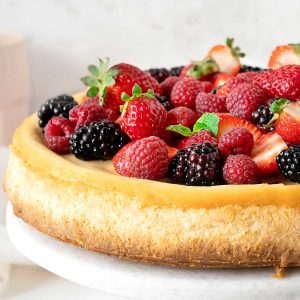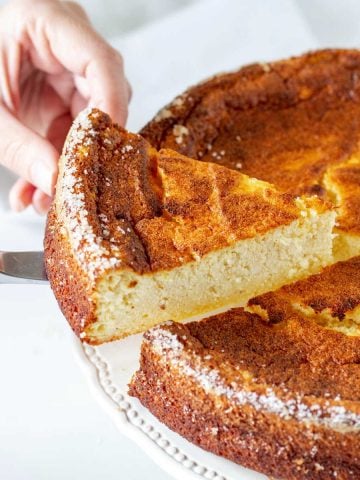This fabulous cheesecake combines cream cheese and ricotta to create a lighter dessert but with a slightly rustic texture compared to regular cheesecakes. A creamy, sweet and barely tangy filling is poured into a buttery graham cracker crust and baked until golden and set. It keeps very well and can be frozen, so you can make it in advance.

Unique dessert
Our crustless ricotta cheesecake is one of the most popular desserts in this blog, so we needed to come up with a recipe that included cream cheese, an Americanized version of this Italian classic, you might say.
It turned out so well!
Ricotta has a mild, slightly sweet flavor and a crumbly texture. So this cake is sweet and creamy but not completely smooth due to the rusticity of the cheese. It's also lighter than regular cheesecakes but without compromising texture.
Like this simple ricotta cake, this cheesecake is a winner for Easter, Mother's Day and other special occasions, or just because you like ricotta and want to try something different.
FAQ
Yes, you can! it keeps very well in the fridge for a few days (and I actually encourage you to make it a day or two before serving) and can also be frozen, allowing you to plan your menu. Always cover it well to prevent dryness.
Yes, but the regular, full-fat type adds creaminess and richness, so it's always my first choice. That said, some brands have good ones that are reduced in fat. You'll have to experiment.

Ingredient Notes
- Graham cracker crumbs: you need fine crumbs, so a food processor is the best appliance. Use store-bought regular graham crackers or homemade graham crackers.
- Ricotta cheese: whole milk ricotta cheese is the best option due to its fat content and texture.
- Cream cheese: the regular type, full-fat cream cheese is needed for consistency and creaminess.
- Sour cream: the regular type, full-fat sour cream cheese is used for richness and creaminess.
- Lemon zest: freshly grated is always better.
Quantities are listed in the recipe card towards the end of this post. The Ingredients page has more details and lists the brands we use.

Variations & substitutions
- Spiced: instead of the lemon zest, add a spice like ground cardamom or cinnamon.
- A mix of citrus: lemon is a traditional Italian flavor, but use a mix of citrus zest like lemon-lime, or lemon, lime and orange zest together for a more unique dessert.
- Liquor: add a tablespoon or two of an orange liqueur (Grand Marnier or Cointreau), or maybe Frangelico (hazelnut liqueur).
- Almond: use ½ teaspoon of pure almond extract instead of the lemon zest and a tablespoon of Amaretto for a deep flavor.
- Cookie crust: use another type of sweet crackers for the crumb base like honey maid graham crackers, cinnamon graham crackers, plain chocolate wafers, or vanilla wafers work well if you want to have a choice.
See this ricotta cheesecake for a crustless, 100% ricotta option.
Steps to make ricotta cheesecake
They are similar to other cheesecakes.

- Crumb crust: the graham cracker crust should be baked for about 10 minutes before the filling is poured into it.

- Filling: the three types of cheese should be at room temperature. This is important to integrate them well. You should be able to combine them easily with a whisk.

- The final batter is thin but not completely smooth, as the ricotta curds don't fully disintegrate.

- Have the oven preheated before you pour the batter into the prepared pan.
Vintage Kitchen Tip
The temperature of the oven and subsequent cooling down of the cheesecake before refrigerating is important to avoid cracks and get a creamy filling. So don't rush it.

Kitchen notes
- Organization: read the recipe first and ensure you have ingredients at the correct temperatures, equipment, and enough workspace. This will make the process so much easier!
- Baking time: keep in mind that all ovens and pans are different, even if they look similar. The baking time in my recipes is as accurate as it can be, but it might take you more or less time. You can use a thermometer (like the OXO oven thermometer) to check that your oven is at the right temperature. I recommend you keep track of how your oven works and what tiny details you might need to adjust.
- Storage: This ricotta cheesecake is kept well in the fridge for days and can be frozen with great results. Always cover well in plastic wrap to avoid dryness, and add an extra layer of aluminum foil if freezing it. Do so without the berries. An airtight container can also be used if storing it in the fridge for up to a week.
- Toppings: besides fresh berries, as we do, you can use any cheesecake topping, homemade or store-bought. We love our fresh cherry sauce, homemade strawberry sauce, or lemon blueberry topping. For a sweeter dessert, use homemade dulce de leche or salted caramel. I don't recommend chocolate sauce as it can overpower the ricotta flavor.

Troubleshooting common issues
Watery texture: this can happen if the ricotta cheese is not drained properly or if the cheesecake is not baked for long enough. To avoid this problem, drain the ricotta if it has excess liquid (this varies depending on the brand) and bake the cheesecake until it is almost set and not too jiggly.
Crumbly texture: overbaking can cause this, so be careful to start checking before the suggested time is up.
Overbrowning: if it becomes too brown on the top or edges before the center is fully cooked, tent it with foil and continue baking.
Cracking: this can happen if the cheesecake is overbaked, cooled too quickly, or oven temperature is too high.

Related recipes you might like:
If you made this recipe and loved it, you can comment below and leave a 5-star ⭐️ review. Also, if you had issues, let me know so we can troubleshoot together.
You can also subscribe to our FREE email series 'Baking the Best' and our regular newsletter. Or follow and save my recipes on Pinterest.
As an Amazon Associate, I earn from qualifying purchases. Read my disclosure policy.

Ricotta Cheesecake
Ingredients
For the crumb crust:
- 1 ½ cups graham cracker crumbs, see Notes for alternatives
- 6 tablespoons unsalted butter, melted
For the ricotta filling:
- 1 ½ cups cream cheese, at room temperature
- 1 ½ cups ricotta cheese, at room temperature (drained if it has excess liquid)
- ⅔ cup sour cream, at room temperature
- ¾ cup sugar
- 4 eggs, at room temperature
- 1 teaspoon vanilla
- 2 teaspoons lemon zest
Instructions
For the crumb crust:
- Preheat the oven to 325°F (170°C).
- Have ready a 9-inch round cake pan with removable bottom (springform pan). Line it with foil if you want to (see Notes below).
- Stir 1 ½ cups graham cracker crumbs with 6 tablespoons unsalted butter in a medium bowl and combine until there are no dry spots and it looks like wet sand. If using the food processor to grind the cookies, add them melted butter and pulse to mix.
- Scatter this mixture in the prepared pan and press firmly onto the bottom. Use your hands or a measuring cup.
- Bake for 10 minutes. Remove from the oven and place on a cooling rack while making the filling.
- Don't turn off the oven.
For the ricotta filling:
- Lower the oven to 275°F (140°C).
- Mix 1 ½ cups cream cheese, 1 ½ cups ricotta cheese and ⅔ cup sour cream in a large mixing bowl until very smooth. You can use a handheld mixer at low speed, or a wire whisk. If the cheese is at room temperature, mixing it by hand should not be a problem. We don't want to incorporate air into the batter.
- Gradually add ¾ cup sugar and mix until it's well incorporated. If using a handheld electric mixer, use it only until this part and at low speed. I use a whisk.
- Add 4 eggs, two at a time, mixing with a wire whisk until fully combined, scraping down the sides of the bowl a few times. Be patient as the egg white sometimes takes a little longer to incorporate, and don't be tempted to beat. This is good for creaminess later.
- Add 1 teaspoon vanilla and 2 teaspoons lemon zest, stirring to incorporate well. The batter can have some ricotta pieces and that is fine, especially if you only use a hand whisk.
- Pour the mixture into the baked crust. It might be warm and that's fine.
- Bake the cheesecake for about 1 hour and 20 minutes, until the top is dry and the filling barely jiggles in the center. It might take you more or less time so start checking 10 minutes before the given time. Don't be tempted to bake it until the center is completely set. It will solidify as it cools down and after it's refrigerated.
- Cool completely to room temperature in the pan on a wire rack, the center will fall a little.
- Wrap in plastic (still in the pan) and refrigerate for at least 6 hours. I usually leave it for 1 day. It's essential to chill it for several hours before eating it.
- When ready to serve, run a smooth-bladed knife carefully around the edges to loosen the cheesecake, open the springform ring, and, using a spatula, lift and transfer the cake to the serving plate.
- Serve cold or at room temperature, plain or with a topping. We love fresh berries that are tangy and make a great contrast with the creamy filling, especially raspberries.
- Store leftovers covered in plastic wrap or in an airtight container in the refrigerator for 4-5 days or frozen for up to a month. For the freezer, I wrap it in cling film first and then aluminum foil. Defrost at room temperature or in the fridge, depending on how much time you have.






Mary says
What is the purpose of lining the pan with foil? Didn’t see anything in the notes about it
Paula Montenegro says
Hi Mary, it will help when it's time to remove the cheesecake from the pan.
Linda P says
I want to compare the nutrition stats with one of your other cheesecake recipes, but I don’t see them here.
Paula Montenegro says
Hi Linda, they're added to the recipe card.